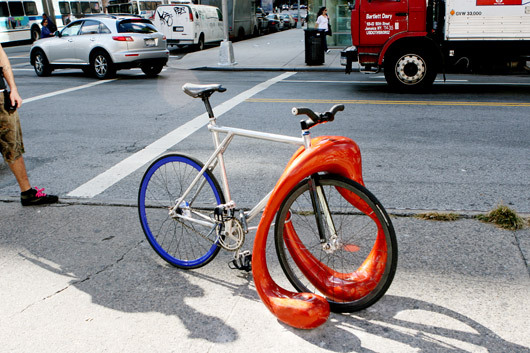“Alien” Bike Rack Selected in NYC Design Competition
By Bustler Editors|
Friday, Nov 7, 2008
Related
It began with a competition. The New York City Department of Transportation and the Cooper-Hewitt National Design Museum, along with Google, wanted to encourage cycling as a convenient method of transportation. After a study revealed that lack of access to secure bike parking was the main deterrent, the two organizations created a contest to develop an innovative bike rack that would raise the profile of cycling in the city. Francis Bitonti, principal with FADarchitecture, jumped at the opportunity to participate.
“Entering the contest seemed like good opportunity,” said Bitonti, whose firm is a young, full-service design firm, with a commitment to innovation. He created a bike rack that uses modular pieces and freeform geometry. He says it looks “alien.”


“A lot of what I do comes out of writing small computer programs that generate forms,” he said. “This form is disconnected but continuous at the same time, operating as a modular system that produces many variations. It is about finding beauty in the unfamiliar.” While this was a benefit in terms of design, it could have been challenging to create without the help of RedEye.
Bitonti designed the rack using animation software “to develop the forms and create an aesthetic sensibility for the project,” he said. He then transferred his work to software typically used for scientific computing to produce complex patterns that would be very time-consuming and difficult to produce any other way.


The complexity was no problem for RedEye. “We are used to creating unusual shapes and forms,” said Ryan Sybrant, RedEye Architectural Development Manager. “We extracted data from Frank’s CAD file, which directed one of our 100 fused deposition modeling (FDM) systems to put down layers of material, similar to the way an ink jet printer puts down ink.
Bitonti originally planned to mill the rack, but the complicated design would have required 200 parts. “Because the design had so many curves,” Bitonti said, “every time it went in a different direction, we would have had to cut one of the pipes. It would have been nearly impossible to fabricate with traditional milling procedures. 3D printing was the most cost-efficient and precise way to manufacture these parts. With RedEye’s FDM technology, only 18 parts were needed. That’s a tremendous difference.”


Even the size of the 18 large bike rack components was not a problem for RedEye. “With our ‘large build envelope,’ we could nest pieces together,” said Sybrant. “Large pieces are not a problem for us.” Assembly was much easier, too. It only took two people, compared to a very large crew that would have been required to assemble the 200 parts created with traditional milling.”
Security is an issue for bikes, especially in a city the size of New York. Bitonti was able to reinforce the plastic bike rack with steel cabling.
A honeycomb interior reduced both production time and cost, an important factor given the city’s limited budget, said Bitonti. “The sparse honeycomb filling still provided rigidity, but at half the cost.”

Bitonti redesigned the rack many times along the way to reduced the number of modular connections, making it easier for bikers to use. Even so, by altering the rotation, position and number of units, one can produce 63 drastically different variations of the design. Bitonti believes the design of his new rack will enable a maximum number of bikes to be stored in limited sidewalk space, keeping the sidewalk more open for pedestrians. Two prototypes of the bike rack were created. One is actually in use on the streets of New York. The other is on display at the Cooper-Hewitt National Design Museum.
Choosing a glossy ABS plastic material from one of RedEye’s 15 choices, Bitonti painted the parts an automotive deep red-orange. “The automotive paint became an excellent way for me to create a kind of living surface that is always changing with the light and relationship of the observer to the object,” he said.
Perhaps the greatest compliment of all came from a potential user who said, “The bike rack is so unique that (thieves) will steal the rack before they steal my bike.”
Images: Francis Anthony Bitonti (FADarchitecture)

Share
0 Comments
Comment as :